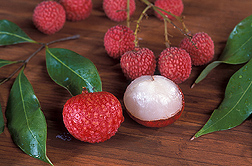Luscious Lychee: Scientists Find
Keys to Plentiful, Predictable Harvests
Many plants prosper in Hawaii’s mild, sunny climate. The long list of contented species includes lychee, or Litchi chinensis, perhaps best known for the flavorful ice cream you can often find at Asian restaurants.
The fruit’s sweet, slightly firm flesh—which has a texture somewhat like that of a peeled grape—can also be eaten fresh or made into elegant sauces, distinctive jams or jellies, and more.
Because Hawaii’s climate doesn’t precisely match that of lychee’s southern China origins, varieties like Kaimana, selected especially for the Island State, are still the best option for growers there.
To further boost farmers’ chances of plentiful, predictable harvests of large, luscious fruit, ARS horticulturists Tracie Matsumoto and Francis T.P. Zee have developed and tested a regimen of pruning and fertilizing Kaimana trees. Now, the scientists and their University of Hawaii colleagues are fine-tuning this management system.
Some growers who’ve tried the protocol have reported impressive yields averaging more than 100 pounds of delicious, nicely sized fruit per tree. Many trees that are now top performers previously produced less than half that much fruit or, in some years, no fruit at all.
None of the procedures are, in themselves, new to orchardists. Instead, it’s the combination, timing, and specific details of each that make the management system different from what many Kaimana growers have tried in the past.
Zee and Matsumoto are with the ARS Tropical Plant Genetic Resources and Disease Research Unit, part of the U.S. Pacific Basin Agricultural Research Center in Hilo, Hawaii.
Taming Untimely Vegetative Growth
The tactics for managing the Kaimana trees are “simple, direct, and effective,” Zee says. The protocol helps orchestrate the first flush of vegetative growth—in which lychee trees develop new leaves and stems and lengthen their branches—to occur immediately after harvest.
Kaimana fruit is usually ready to harvest in May through July.
“Normally, lychee trees will have three or four flushes of vegetative growth in the course of the year, depending on rainfall and temperatures,” Zee says. “The new growth needs to be mature by fall, before the arrival of our December-through-February cool period. The trees have to have at least 10 days to 2 weeks of cool temperatures in order for these mature branches to flower and fruit in spring. Untimely vegetative flushes, especially flushes that occur too close to our cool season, interfere with the start of flowering and result in irregular, unpredictable fruiting.”
The tactics Zee and Matsumoto have tested combine pruning 1 to 2 feet off of every branch at harvest, followed 1 week later by applying fertilizer as a foliar spray.
Pruning at harvest is practical. Says Zee, “The crew that harvests can also prune. Pruning at harvest helps synchronize vegetative growth of the trees and results in more uniform flowering and fruiting.”
The new protocol specifies that two different kinds of fertilizers—granules and the foliar spray—are needed at different times and in different amounts. “You want to apply granular fertilizer on the ground when the young fruit reaches pea size. By doing that, you will promote fruit growth and good size,” Zee notes.
After harvest, foliar fertilizer synchronizes prewinter vegetative growth of all the trees.
The management system is based on 6 years of observation and experimentation with Kaimana trees growing on the rainy side of Hawaii Island. Now, Matsumoto is determining how to make the tactics as successful in the island’s other microclimates. She’s doing the work in demonstration sites within commercial lychee orchards. These projects have attracted the interest of beginning and experienced farmers alike.—By Marcia Wood, Agricultural Research Service Information Staff.
This research is part of Plant Genetic Resources, Genomics, and Genetic Improvement, an ARS national program (#301) described on the World Wide Web at www.nps.ars.usda.gov.
Tracie Matsumoto and Francis T.P. Zee are with the USDA-ARS Tropical Plant Genetic Resources and Disease Research Unit, U.S. Pacific Basin Agricultural Research Center. Contact Matsumoto at 64 Nowelo St., Hilo, HI 96720; phone (808) 959-4358, fax (808) 959-3539. Contact Zee at 928 Stainback Hwy., Hilo, HI 96720; phone (808) 959-5833, fax (808) 959-3539.
"Luscious Lychee: Scientists Find Keys to Plentiful, Predictable Harvests" was published in the May/June 2009 issue of Agricultural Research magazine.







